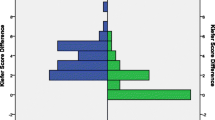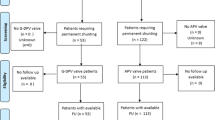Abstract
Introduction
The aim of the study was to describe the authors’ experiences with the adjustable gravitational proGAV shunt system in treating infants’ hydrocephalus.
Patients and methods
The proGAV was implanted in 29 infants (11 boys and18 girls, median age 9 months) with hydrocephalus of various origins between January 2010 and June 2014. The opening pressure was chosen based on the intraventricular pressure which was measured during operation, and a gravitational unit with a fixed opening pressure (15 cm H2O) was selected.
Result
Regular clinical follow up ranged from 6 to 36 months, with a mean follow-up time of 15.7 ± 7.9 months. Five of these patients (17.2 %) underwent shunt revision because of malfunction, including two infections (6.9 %), two shunt exposed (6.9 %), and one proximal catheter occlusion (3.4 %). For readjustment in 10 infants, the opening pressure was changed at least once during the follow-up period.
Conclusion
The proGAV is efficacious in the treatment of hydrocephalus in infants. This individual selection of the opening pressures makes it probable that a better match of chosen opening pressure and actual hydraulic requirements of the patient might occur.





Similar content being viewed by others
References
Berry JG, Hall MA, Sharma V, Goumnerova L, Slonim AD, Shah SS (2008) A multi-institutional, 5-year analysis of initial and multiple ventricular shunt revisions in children. Neurosurgery 62:445–453
Cedzich C, Wiessner A (2003) The treatment of hydrocephalus in infants and children using hydrostatic valves. Zentralbl Neurochir 64:51–57
Eymann R, Steudel WI, Kiefer M (2007) Pediatric gravitational shunts: initial results from a prospective study. J Neurosurg 106(3 Suppl):179–184
Gebert AF, Schulz M, Haberl H, Thomale UW (2013) Adjustments in gravitational valves for the treatment of childhood hydrocephalus-a retrospective survey. Childs Nerv Syst 29(11):2019–2025
Haberl E, Messing-JuengerM SM, Eymann R, Cedzich C, Fritsch MJ, Kiefer M, Van Lindert EJ, Geyer C, Lehner M, Rohde V, Stroux A, von Berenberg P (2009) Experiences with a gravity-assisted valve in hydrocephalic children. J Neurosurg Pediatr 4:289–294
Meling TR, Egge A, Due-Tønnessen B (2005) The gravity-assisted paedi-GAV valve in the treatment of pediatric hydrocephalus. Pediatr Neurosurg 41:8–14
Preuss M, Kutscher A, Wachowiak R, Merkenschlager A, Bernhard MK, Reiss-Zimmermann M, Meixensberger J, Nestler U (2015) Adult long-term outcome of patients after congenital hydrocephalus shunt therapy. Childs. Nerv Syst 31(1):49–56
Prusseit J, Simon M, von der Brelie C, Heep A, Molitor E, Volz S, Simon A (2009) Epidemiology, prevention and management of ventriculoperitoneal shunt infections in children. Pediatr Neurosurg 45:325–336
Reddy GK, Bollam P, Caldito G (2014) Long-term outcomes of ventriculoperitoneal shunt surgery in patients with hydrocephalus. World Neurosurg 81(2):404–410
Reddy GK, Bollam P, Caldito G, Guthikonda B, Nanda A (2012) Ventriculoperitoneal shunt surgery outcome in adult transition patients with pediatric-onset hydrocephalus. Neurosurgery 70(2):380–388
Rhode V, Haberl EJ, Ludwig H, Thomale UW (2009) First experiences with an adjustable gravitational valve in childhood hydrocephalus. J Neurosurg Pediatr 3:90–93
Rohde V, Mayfrank L, Ramakers VT, Gilsbach JM (1998) Four-year experience with the routine use of the programmable Hakim valve in the management of children with hydrocephalus. Acta Neurochir 140:1127–1134
Shah SS, Hall M, Slonim AD, Hornig GW, Berry JG, Sharma V (2008) A multicenter study of factors influencing cerebrospinal fluid shunt survival in infants and children. Neurosurgery 62:1095–1102
Sprung C, Schlosser HG, Lemcke J, Meier U, Messing-Jünger M, Trost HA, Weber F, Schul C, Rohde V, Ludwig HC, Höpfner J, Sepehrnia A, Mirzayan MJ, Krauss JK (2010) The adjustable proGAV shunt: prospective safety and reliability multicenter study. Neurosurgery 66(3):465–474
Stone JJ, Walker CT, Jacobson M, Phillips V, Silberstein HJ (2013) Revision rate of pediatric ventriculoperitoneal shunts after 15 years. J Neurosurg Pediatr 11(1):15–19
Thomale UW, Gebert AF, Haberl H, Schulz M (2012) Shunt survival rates by using the adjustable differential pressure valve combined with a gravitational unit (proGAV) in pediatric neurosurgery. Childs Nerv Syst 29(3):425–431
Vinchon M, Baroncini M, Delestret I (2012) Adult outcome of pediatric hydrocephalus. Childs Nerv Syst 28(6):847–854
Zemack G, Bellner J, Siesjo P, Stromblad LG, Romner B (2003) Clinical experience with the use of a shunt with an adjustable valve in children with hydrocephalus. J Neurosurg 98:471–476
Conflict of interest
The authors declare that they have no competing interests.
Author information
Authors and Affiliations
Corresponding author
Rights and permissions
About this article
Cite this article
Xinxing, L., Hongyu, D. & Yunhui, L. Using individualized opening pressure to determine the optimal setting of an adjustable proGAV shunt in treatment of hydrocephalus in infants. Childs Nerv Syst 31, 1267–1271 (2015). https://doi.org/10.1007/s00381-015-2795-2
Received:
Accepted:
Published:
Issue Date:
DOI: https://doi.org/10.1007/s00381-015-2795-2




